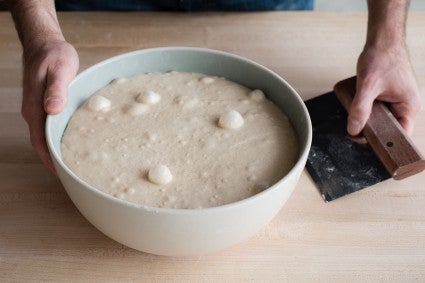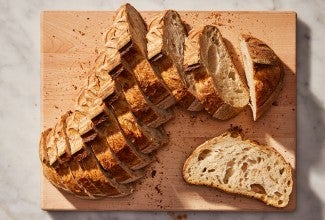Ask the Bread Coach: My dough isn’t rising — what now?
The best solution is patience. But if you don’t have that, there are some other tricks.


In the two years that I’ve been working with my bread coach (aka Martin Philip), one question has plagued me more than any other: In my cold, drafty house, how can I get my dough to rise faster?
My frigid fingers have typed that question in a text message to the coach countless times, but I’ve always been reluctant to press send. I figured that there wasn't actually a problem with my dough. The problem was my (lack of) patience.
Turns out I was right. “Home bakers chronically underferment their bread,” Martin told me when I finally confessed my problem. For bakers like me, he said, patience really is a problem: We get sick of waiting and put our breads into the oven before they’re truly ready. The result is squat loaves and dense crumbs — still edible, but nowhere near ideal.
Can my bread coach make me a more patient person? (Can anyone?) Nope. But the coach did have some other workarounds for slow-rising dough.
David Tamarkin: When people come to you and say their dough isn’t rising, what’s your first piece of advice?
Martin Philip: First and foremost, I ask if and how they’re measuring their ingredients. And when I say “measure ingredients,” I mean measuring temperatures as well. What was your water temperature? What is the dough’s temperature? Measuring temperature is as important as measuring the amount of salt or the amount of yeast.
Two, what's the quality of your leaveners? Are you using a sourdough culture that’s in poor health? Are you using the right kind of yeast?
If you’ve controlled temperature and you’ve controlled leavening, you should be on a proper course. The only other thing you want to think about is the ambient temperature of the room. If it’s cold in your house, your dough will be sluggish, so you’ll want to find a warm spot for it to rise.
When you control for temperature — the temperature of the dough and of the room — you can get your dough into the Goldilocks zone for optimal fermentation.
DT: Taking the temperature of the ingredients and the room is all in service of achieving Desired Dough Temperature (DDT). But a lot of recipes don’t give you a DDT to aim for. Is there a general range people can look for that will put them in that “Goldilocks zone” for rising dough?
MP: There are a lot of variables, but in broad terms we’re aiming for between 75 and 80 degrees. That’s our sweet spot.
DT: And that’s true for a sourdough country loaf, and challah, and a white sandwich bread …?
MP: Yup. We can get a lot more persnickety about it, but if you aim for bread dough in the 75 to 80 degree zone, you'll be off to a good start.

DT: Let’s say I’ve mixed my dough, taken it’s temperature with an instant-read thermometer, and discovered it’s running cool — 70 degrees. My house is pretty cool — 67 degrees.
MP: Unfortunately, dough likes an ambient temp that is higher than room temp. If your room is between 70 and 72 degrees, you should be good, as long as your dough is in that 75 to 80 degree range. But if you have a cool dough, a cool room isn’t going to do anything to warm it up. You’ll have to make some adjustments: You’re either going to reduce fermentation in the case of a warm dough, or, in the case of a cool dough, extend fermentation.
DT: In other words, if the dough is sluggish and cool, I should just let it rise for longer.
MP: Exactly. If you can’t control for temperature, you can control for time. So you may want to increase the length of bulk fermentation by 25% to 50% of the time listed in the recipe.
DT: Let’s say I have somewhere to be, or I’m just feeling impatient. Is there anything I can do to speed up fermentation?
MP: Yes. You can do everything possible to increase the temperature of the dough by adjusting ambient conditions. Problem is, it’s very hard to get warmth into a dough. It’s much easier to cool a dough down than to warm it up. But if you have the Brod & Taylor Proofing Box, that’s a pretty good way to warm it up.
DT: Everybody loves that thing! What temperature do you set it at to speed up a sluggish dough?
MP: 80, 85 degrees. It’s got to be like a warm embrace, you know? Bakeries run proofing boxes at around 85.
But almost as good as a proofing box is taking a Mason jar filled halfway up with water, microwaving it for two minutes, then putting your bowl of dough into the microwave with the jar to rise.
The other thing you can do is place your lidded container or bowl of dough into a second, larger bowl of warm water. Water that’s, say, 105 to 120 degrees. Just make sure your dough is sealed water-tight!

DT: What about using the oven? People often recommend putting dough in there with the oven light on …
MP: I think the oven causes more problems than it’s worth. Because somebody is likely to turn that oven on. So yeah, I guess you can use the oven. But you have to be careful. Put a sign on it that says “Don’t touch!”
DT: No thanks, I think you’ve successfully scared me off that one. What about heating pads?
MP: Heating pads work. Or if you’re a gardener and have one of those heated seed mats for germination, that will work too.
Or you can simply get your Thermapen out and start walking around your house, searching for the warm spots. If you’ve got a refrigerator with cabinets above it, that’s often a warm place for rising dough.
But with all of these options you have to be careful that you don’t get the dough too warm. Otherwise you’ll end up with a dough that’s overproofed.
DT: Which is another fear of home bakers. How can they avoid that?
MP: If you keep your dough at the correct temperature and you check it as it rises, you’re likely to catch it before it overproofs. But if, despite your best intentions, you do overproof your loaf, you’ve learned something! And that's progress in itself. The only way to get better as a baker is through repetition. You’ve got to get some experience. You’ve got to get some reps. But really, I think bakers tend to underproof more than they overproof. [Ed. note: if you do end up overproofing your dough, here are some ways to save it.]
DT: What if I’m an hour into bulk fermentation and my dough isn't rising at all? Can I just, like, knead in some more yeast?
MP: I mean, you can, but that opens a whole other can of worms. Rather than do that, I would look to extending fermentation if your dough isn’t rising quickly. Or just go ahead and bake your bread. Accept that you did the best you could that day, and try again tomorrow.
DT: Ouch.
MP: Hey, it happens. But when you do come back tomorrow, knowing that your house is cold, aim high. Aim for a dough temp of 82, 83 degrees, which might mean that you start with hotter water at the outset, and employ some of the other tricks, like a heating pad or the microwave move, because you know the dough temperature is going to drop quickly in your cold house if you don’t do something to maintain it. I guess that’s my main tip for this entire problem. Aim high! Good advice for life, but particularly for bread.
Cover photo by Mark Weinberg; food styling by Liz Neily.


